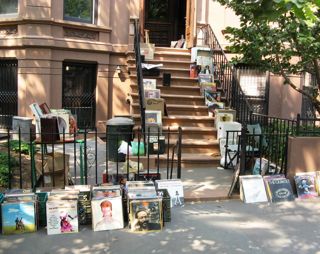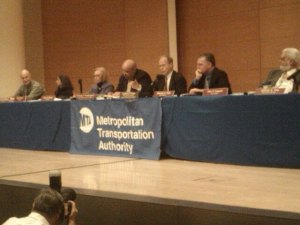Though the small Park Slope playground buzzes with the usual sounds of children playing one Sunday afternoon, the dark green field behind it doesn’t see nearly as much use. Two men are the only ones around, lazily kicking a soccer ball back and forth between them.
Looking on, 7th grader Justin Miro kicks at the synthetic turf field, spraying up dozens of little black pellets that hit the ground and are lost again amongst the plastic green stalks. “How do they do that?” he wonders aloud, watching the two men on the ground. “That burning tire stuff really stinks. Why can’t they put real grass?”
In the Brooklyn home of the city’s second largest park, a redevelopment of a small 5th avenue playground has turned into one big stink. Launched in 2008 with heavy financing from City Council members de Blasio and David Yassky, the project was completed earlier this year and included two new basketball courts, eight handball courts, a track, and the conversion of an asphalt yard into a synthetic field.
But the addition of the synthetic field has remained a heated issue, as local residents and parents charge that material used in the turf poses a serious health risk and demand it be replaced. Though the synthetic turf industry and Parks Department have insisted on the field’s safety, the debate has threatened this Summer’s potential park goers, as advocates call for a boycott of the space.
Artificial turf is made of crushed stone or sand-like material, plastic blades of grass, and bits of rubber. Critics point to a number of studies that have found the rubber to become increasingly toxic as it slowly wears away with use and exposure to sunlight. The rubber, known as “crumb rubber,” comes from recycled tires considered “special waste” by the New York State Department of Environmental Conservation because of the toxins and carcinogenic chemicals they contain.
Critics like Geoffrey Croft, president of the NYC Parks Advocates group, claim the turf has a long list of potential hazards. “As those fields deteriorate, the lead content of the rubber can rise dramatically,” he said in a telephone interview. “The turf does not dissipate heat and, particularly on summer days, can easily get 60 to 70 degrees hotter. So you have all this heat wearing away at the turf people are playing and breathing around.”
A fact sheet from the New York State Department of Health cites three studies of crumb rubber that show the temperature of synthetic fields reaching as high as 200 degrees.
Last year, a park in East Harlem was temporarily closed when high levels of lead were found in its synthetic field, which led the city to conduct tests at over 100 areas where the turf is used. The evaluations showed that “newer fields had no lead or generally had the lowest lead levels. Although small amounts of lead were detected on the surface of some fields, none of the tested fields released amounts of lead that would pose a serious health risk to children.”
Many Park Slope locals are unconvinced. “They want to say that it’s safe for these kids to be rolling around playing soccer in stuff that’s got low levels of lead in it,” said Greg Tucker, who coaches a children’s soccer team on weekends. “I’m sorry, but I don’t want them playing in something with any level of lead in it, regardless of how low that may be.”
Others agree that the synthetic turf is not their first choice for the renovated park, but acknowledge the difficulty maintaining natural grass fields in crowded city parks during the summer months.
“The park has tried for years to keep these little patches of grass green,” said park volunteer Matt Lambaise. “But between soccer and football, they are too small and overused to stay that way for any length of time.”
Kim Maier, is executive director of Prospect Park’s historical landmark, The Old Stone House, where the first battle of the American Revolution was fought. “The area covered by turf was nothing but asphalt for as long as anyone can remember,” she says. “Fake or real, the field is a definite community asset in terms of open space.”
Since the project’s completion, a number of concerned residents have joined forces in refusing to visit the new park until a safer alternative to the turf is decided upon. Audrey Komroff, “full-time mom” and head of a local advocacy group, is proposing a boycott this summer, suggesting others instead take the hike from 5th avenue up to Prospect Park.
Sheelah A. Feinberg, a spokeswoman for the group New Yorkers for Parks, explained “We’re not saying no to these fields. We’re trying to find a way to say yes to them. The reality is that we can’t afford to maintain grass in all the city’s parks, but because the technology changes all the time, a future standard for selecting all recreational equipment must be established.”




